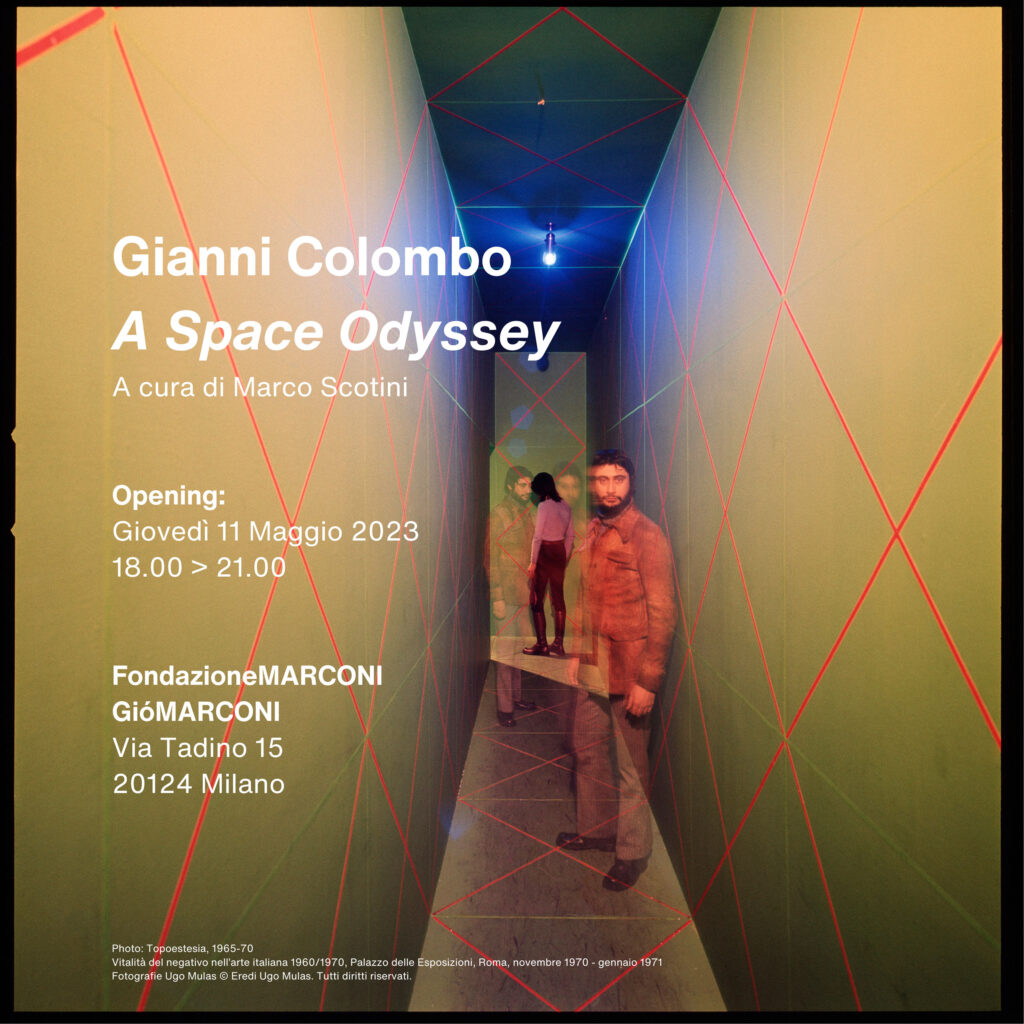Curated by Marco Scotini

Fondazione Marconi and Gió Marconi are pleased to announce Gianni Colombo. A Space Odyssey, an
important retrospective dedicated to the Milanese artist on the occasion of the 30th anniversary of his death.
The exhibition focuses on the particular spatial dramaturgy that characterises Colombo’s work, starting
from a comparison with 1968 Stanley Kubrick’s spectacular sci-fi movie.
Considered one of the greatest international exponents of kinetic and environmental art, Gianni Colombo
made the link between space and body the catalyst for all his three-dimensional investigations. Using
flashes of light, moving objects, immersive environments and isolated architectural elements, the artist
created disturbing spatial devices capable of disorienting acquired perceptual forms and deconstructing
ordinary behavioural codes.
In perfect union with Lygia Clark, throughout the 1960s Colombo challenged rigidity with the mise-en-scene
of elasticity. However, during the 1970s he put gravity at the centre of his personal challenges. It is not by
chance that the three large installations conceived for Studio Marconi during this period – Campo
praticabile (1970), Bariestesia (1975) and Topoestesia (1977) – mark a fundamental stage in his journey in
this direction, confronting gravity as an equally inevitable and invisible factor to be overcome. Electronic
bands on TV screens, baresthesic perception (a condition of equilibrium) and the progressive replacement
of cubic space with curved space determine his work in his period.
It is in fact with the curved platform of Campo praticabile [Practicable field], that Colombo created a
walkable environment on the floor of the gallery in collaboration with Vincenzo Agnetti. As Agnetti later
wrote: Given a base: the floor, a platform or something else, identifiable at the threshold of sensitivity, we
already have a field consisting of two hemispheres: the upper one as a positive virtual field tending towards
redundancy, and the lower one as a predicted unpredictable negative field.
Also in 1970, an extraordinary photo by Ugo Mulas portrayed one of the three corridors of Topoestesia
(presented at the Vitalità del Negativo exhibition) as a centrifugal space. All four perimeter walls converge
towards the back wall, creating the visual effect of a torsion, thus excluding the identification of any
reference axis. Gianni Colombo is at the centre of the image: his feet rest on one side wall, his torso on the
other in front, and his hands are compressed on the surface. If the image were rotated 45 degrees, the side
wall would immediately transform into the floor. The impression is therefore of a photograph taken in a
spacecraft with the astronauts’ bodies orbiting in an anti-gravitational space.
Moreover the Apollo 11 moon landing took place in July 1969 and Topoestesia (Planned Itinerary) was
shown just a year later. Stanley Kubrick’s sensational sci-fi film, 2001: A Space Odyssey from 1968 could be
another important reference not only for these works but also for many others Gianni Colombo conceived
throughout his career. The purpose of the exhibition is to focus on the artist’s challenges to gravity and on
his idea of inclined surfaces: an aspect which was shared by many contemporary dance choreographers of
the time, from Yvonne Rainer to Simone Forti. From the earliest ceramic works Costellazioni Intermutabili
[Interchangeable Constellations] from the 1960s to the suspended, moving metal structures Spazi Curvi
[Curved Spaces] from the 1990s, and interspersed between these, the reconstruction of several
fundamental environments (Bariestesia, 1973 and Topoestesia, 1977), through which a part of Studio
Marconi’s history is reconstructed. In essence, Gianni Colombo: A Space Odyssey offers a journey inside a
strange space machine in the company of an exceptional crew (Vincenzo Agnetti, Ugo Mulas, Joe Colombo
and Livio and Piero Castiglioni). A journey that effectively questions the certainty of our Cartesian
coordinates.
The idea of the exhibition of associating Colombo’s spaces to the ones set in Kubrick’s movie arises from
the use, in both cases, of a perceptual disorientation in order to make our bodies re-establish a state of
balance as an open process, thus responding to a sensory disruption with a physical readjustment carried
out by experience and far from abstraction.


